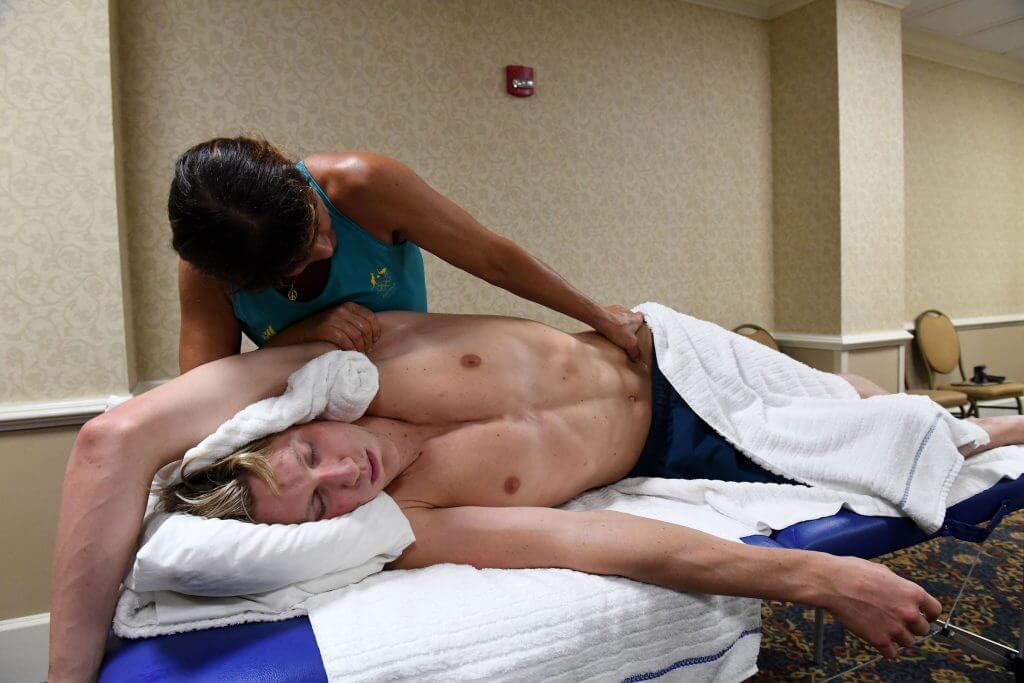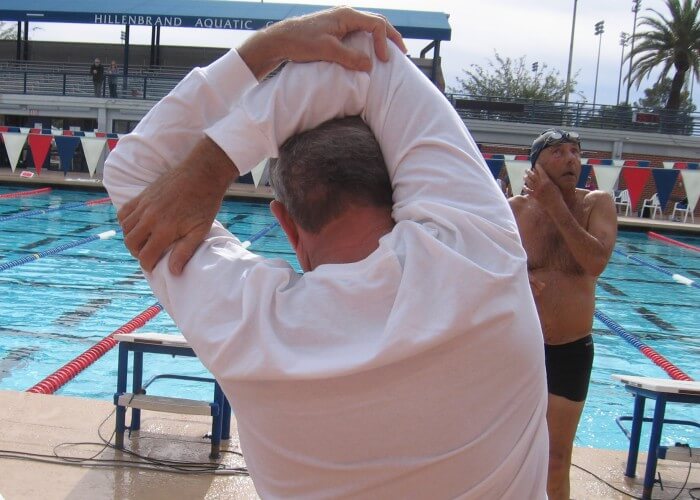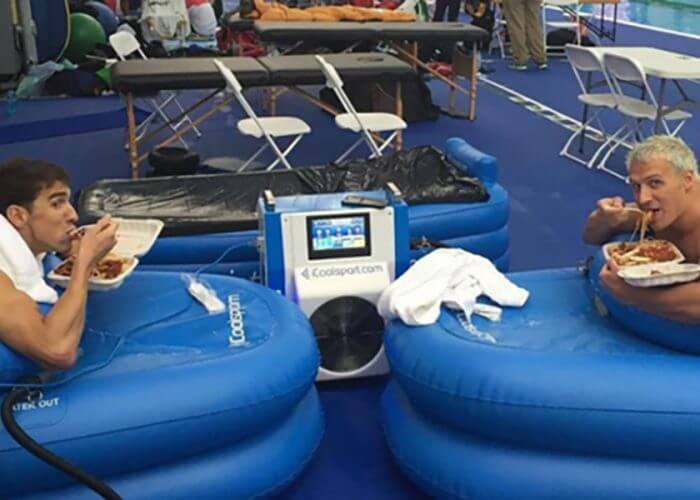Soreness and Recovery Tips That Can Benefit the Body

Soreness and Recovery Tips That Can Benefit the Body
By Daniel Zeng, Swimming World Intern
Discomfort is not an uncommon feeling. We use it to motivate ourselves to be better, or as a sign that we are actively trying to get out of our comfort zone, literally and figuratively. One thing swimmers know too well is the soreness experienced in the midst of the main set, exiting the car at home, the whole next day, and so on. Regardless of when the pain hits our muscles, it hurts.
Distinguishing between routine soreness and possibly serious injury is a skill we need to develop. If we become overly sore, necessary steps can be taken to mitigate it and prevent the soreness from becoming more severe. Otherwise, we might brush it off thinking it is probably another one of the pains we have felt countless times. Knowing how to properly reduce soreness before a workout, or alleviating pain when it sets in after a workout, is vital in maintaining consistency at practice and tranquility throughout normal life.
Defining The Borders
Experts at the health website Healthline define the pain felt during or right after exercise as “acute muscle soreness.” That burning feeling is often the result of a rapid increase in lactic acid. Acute muscle soreness only remains for a very short time and is not what you feel in later days.
What you feel then is referred to as “delayed-onset muscle soreness.” Unlike the acute type, DOMS is owed to very small tears in muscle fibers, to which the body produces inflammation to combat this more intense pain. Swimmers are susceptible to DOMS, as eccentric exercise, when muscles stiffen and elongate simultaneously, is the prevalent source. Eccentric exercise is exactly what swimming is.
The consensus of when pain exceeds the expected soreness and becomes injury-like is somewhere around three to five days. As a swimmer who is accustomed to pain, it can sometimes be challenging to recognize when to ease off pushing my limits and emphasize recovering fully enough to continue training efficiently as soon as possible. The worst-case scenario for anyone is to push their body too hard to injury, potentially putting them out of the water for an extended period.
Choices outside the water affect the pain intensity just as much as the training itself. Basic human needs ought to be met: Sleeping eight hours or more depending on the individual, consuming a nutrient-rich diet, drinking enough water, etc. This is not merely a swimmer problem. Here are some ways to reduce your soreness.
Primary Line of Defense: Sleep and Hydration

Photo Courtesy: Pexels
I want to emphasize sleeping enough. I know that I, and most likely many of you, often sacrifice sleep because we feel that we could use that time to complete other tasks like schoolwork or browsing social media. Sleep should be a priority and is highly underestimated in the benefits it provides. Getting in bed fully 20 to 30 minutes earlier than usual adds up to a minimum of two extra hours of rest per week. This is your first line of defense in controlling the pain.
HYDRATE PLEASE! Drink plenty of water, aside from the chlorinated kind, to replace lost water from sweat, and to refuel those muscles.
Clean up Your Diet
If you are sleeping adequately and drinking lots of water, but continue to experience persistent pain, try altering your diet, and eating more whole foods. In particular, include more anti-inflammatory foods such as berries and chocolate to negate the inflammatory effects of DOMS. Choose fresh fruits and veggies, and cook more of your meals, since you can see more of what exactly is going into your body.
Strength. Conditioning. Stretching.

Photo Courtesy: Jeff Commings
On another note, stretching, doing dryland conditioning, and strength exercises, all aid in minimizing the magnitude of your expected aching. Do not go too heavy on weights. Otherwise, you might pull a muscle, damage tissue, and be out of the pool for who knows how long. Emphasize increasing flexibility over increasing the total weight lifted. Specific exercises will be more appropriate for separate stroke specialties such as distance freestyle.
Think about it as using a sharp versus a dull knife. A sharp knife cuts faster, while dull ones cut slower, possessing a higher chance of slipping and slicing fingers. In other words, bring the weight rather than throw the weight, so not using momentum but tightening and strengthening whatever muscles you are working. This is so you do not injure yourself further than you already are, or have little to no benefit by not working enough.
Personally, I have put most of my focus on maintaining my core because the majority of your power is produced there, which is probably why coaches frequently tell their swimmers to tighten their core.
Learn the correct technique before incorporating an exercise into your conditioning sessions. When your coach has you work on adjusting your technique at a relaxed or smooth pace, then gives a speed set to have you work on the technique you just practiced, is essentially what was just explained.
Other Options
If those options do not bring relief, incorporate other physical activities into your schedule. Focus on a reduced amount of muscle groups, as opposed to the whole body during swim practices. Cycling and running are good lower body exercises; bowling and kayaking are good for the upper body.
Taking some rest days is a last resort decision if the pain is creating an adverse effect on other parts of your day. Spend these days with friends and family, music, enlightening scenery, to make these days fun. After all, it is a REST DAY. No matter how much it hurts, remember to move your limbs as much as possible to maintain smooth blood flow.
Relief Methods
On the opposite side, literally and figuratively, is the soreness promptly following a practice. Below are some ways to quickly and effectively recover from one.
Cold/Hot Baths & Herbal-Like Products
Taking a bath is a luxury we all desire, more so for athletes like swimmers. Every single muscle, bone, and joint, is spent to move us powerfully through the water.

Photo Courtesy: Instagram, @ryanlochte
Cold baths are most suitable for right after practice since they constrict your muscles, restricting blood flow, allowing your body temperature to lower from the workout, thus limiting inflammation.
Hot baths are most useful for calming the muscles at least a day after practice. Mike Baer of ReboundMD Physical Therapy states: “Heat therapy is beneficial for stiff joints and muscle pain because it allows blood vessels to relax and increases circulation.” Heat also re-energizes muscles and fortifies blood tissue, responsible for moving minerals around the body.
Tiger Balm, Salonpas, Biofreeze and Icy Hot aid aches by administering a freshening, cooling feeling. These products commonly contain mint-derived menthol, used to cool the body after strenuous exercise.
Massages
Multiple 2017 studies indicated massages up to three days post-workout caused substantially reduced soreness, compared to if you do not receive one. To massage, rub lotion on tender spots, then wiggle to loosen muscles. Gliding your limbs and muscles over a foam roller would be useful as well.
Physical Therapy
Once the pain imparts excruciating discomfort in completing everyday tasks, you should go see a doctor. They will most likely recommend you see a physical therapist to discuss personalized plans based on your current physical state.
Dr. G. John Mullen expresses that multiple individuals’ bodies will react and respond to the same amount of exertion differently, depending on physical conditioning, genetics, and other variables. The mentioned tips are great general recommendations but certain ones will work the best, depending on the individual. There is not one cure-all method out there. You know your body the best, and what works best for you.
All commentaries are the opinion of the author and do not necessarily reflect the views of Swimming World Magazine nor its staff.




??